You know when you have back pain, everyone and their dog wants to give you advice. Like being pregnant but without the little bundle of joy at the end of it.
I know people mean well, but there are some common misconceptions out there which we hear A LOT and though said with the best intentions, really won’t help you at all. In fact, some can make it worse.
So, read on, and we’ll do our best to debunk some of the myths surrounding back pain, so you can say a silent ‘thanks but no thanks’ the next time someone tries to bestow their wisdom upon you.
1. Rest
Probably the most common ‘advice’ people hear. I think back in the olden days, this was what we were told to do when in fact, during extended periods of inactivity, muscles can weaken and grow stiff and ligaments and tendons can also lose flexibility and leave you more vulnerable to further injury.
Just like us, our tissues (including our intervertebral discs) need nutrients to stay healthy. By moving, we promote good circulation which in turn delivers nutrients and oxygen to the tissues to help them repair. Incidentally, this is also a reason why sports massage is so great, but that’s another post in itself
2. Ice the pain
Brrr, as I’m writing this it’s November and about 4 degrees outside so the thought of ice on my back is painful right now! To be fair, even if it was 30 degrees today, you can bet that as soon as the ice touches your skin, your poor achy muscles will immediately tense against the chill.
For a back which is already tense, and potentially in spasm, we would recommend heat rather than cold. A warm bath (now that’s a nice thought) or hot water bottle can help the muscles relax and reduce any spasms. Cold is better used for inflammation, when you need to reduce swelling.
3. Don’t exercise
Au contraire! Now obviously this depends on how acute your pain is and the severity of your injury but when you can, and within pain-free limits, exercise is one of the best things for back pain. The weaker your muscles, the more vulnerable you are to pain and further damage. Keep your body mobile, and work on activating and strengthening your deep core muscles to strengthen your spine’s support network.
4. Once your back has ‘gone’ you’ll always have back pain
If you don’t act to help yourself, then maybe, yeah. But nobody should just accept that back pain is something they must live with forever. Most back pain can be helped by strengthening the core and back.
One study found 80% of patients with back pain had weakened muscles in their back. It’s not known whether the weakness was a cause or result of their pain, but by strengthening these muscles, and working on maintaining this strength it’s possible to significantly reduce pain or eliminate it altogether.
If you spend long periods of time with your legs flexed at the hip (such as when sitting or cycling) and are experiencing stiffness or aching in your back, there is a chance that a tightening of your Psoas muscle (right) could be a contributing factor.
The muscle attaches the leg to the back and is responsible for flexing the hip.
It will adaptively shorten when in a flexed state for extended periods and because it attaches to the lower back, as it shortens it can pull on the spine which can in turn cause stiffness and pain.
In this short clip below, Sally demonstrates how to effectively stretch the Psoas to ease any tightness.

How is The Back Made Up?
Your spinal column provides support for your body. Without it, you wouldn’t be able to stand upright, bend or twist.

Vertebrae
Your spine consists of 33 bones (your vertebrae) linking your skull and pelvis. Each vertebra has 3 main components;
1. The vertebral body at the back of the vertebrae which supports your body weight
2. The vertebral arch at the front of the vertebrae which protects the spinal cord.
3. The transverse and spinous processes which serve as sites for ligament attachment.
Facet joints connect the vertebrae and allow the bones to glide smoothly against each other. The joints contain synovial fluid which acts as a lubricant and protects against wear and tear.

The Spine
The spinal column is made up of 4 different regions:
Cervical (neck)
Thoracic (chest)
Lumbar (low back)
Sacral (pelvic)
The spine has a natural ‘S’ shaped curve when viewed from the side. The cervical and lumbar regions have a concave curve and the thoracic and sacral regions have a slight convex curve. These curves allow the spine to act like a spring, absorbing shock and maintaining balance.
Running through the spinal column, protected by the bones, is the spinal cord. This is a cylinder of nerve tissue which connects your brain to the rest of your body, controlling your movement and keeping your organs functioning.

Intervertebral Discs
The vertebrae are separated by soft, fluid filled cushions called intervertebral discs, which sit between the bones. It’s their job to act as shock absorbers, protecting the vertebrae and spinal cord from injury and/or trauma
Your intervertebral discs have a tough outer fibrous ring called the anulus fibrosus which contains and protects an inner gel-like centre called the nucleus pulposus. The nucleus pulposus is made up predominantly of water which can move in and out of the disc through small pores as the disc is loaded and unloaded.
Ligaments
A network of ligaments and muscles join everything together to form the spinal column.
Ligaments are tough bands or sheets of connective tissue and link bones together. The spinal ligaments help stabilise the joints by restricting excessive movements and preventing movement in certain directions.
Muscles
The muscles of the spine work together to support the trunk, protect the spine and hold your body upright. They also allow you to bend, twist and move in multiple directions.


The erector spinae group (above) are a set of muscles which work together to straighten the back and keep you upright. Running almost the full length of the spine, they are made up of The Iliocostal, Longissimus and Spinalis muscles and play an important part in posture and support of the spine.
Another significant muscle used in the stabilisation of the lumbar spine is the Multifidus muscle (left). Together with the transverse abdominis and pelvic floor muscles, it stabilises the low back and pelvis before movement of the arms and/or legs takes place.

The transverse abdominis muscle (right) is the deepest of the abdominal muscles and wraps around the trunk from front to back. In Addition to supporting the organs located in the trunk, it acts as girdle, stabilising the back and pelvis prior to movement of the body. 1 Likes
Evidence shows that deconditioning because of pain and reduced activity in people who have chronic back pain can result in weakened muscles of the low back and spine.
Understanding Back Pain and Mechanics: The back can only be strengthened effectively when the lumbar spine is moving against resistance. If you experience back pain, you may unknowingly alter your body mechanics to protect your back, using pelvic motion instead of lumbar motion.
Strengthening Exercises: Focus on exercises that target the lumbar spine, such as specific back extensions, planks, and other resistance-based movements that engage the lower back muscles directly.
When we talk about the muscles of the back, we are referring to the lumbar extensor muscles at the back (right) which are attached to the spine and stabilise, rotate and extend the back.


When we talk about the core muscles, however, we are referring to the muscles of the trunk (Rectus Abdominis, Obliques and Transverse Abdominis – left – as well as the lumbar extensors) which surround the mid-section, front and back like a corset, stabilising the trunk as the limbs move, providing support for the back and helping us bend and rotate.
Make a invest on timeshare if you need to cancel this guide on how to cancel a time share
Symptoms
It’s not possible to tell whether the weakness causes the pain, or is as a result of the pain, but if you have any of the following symptoms, you may one of many who have weakened muscles of the low back and core:
Pain, aching or stiffness when on your feet for long periods
It is the primary job of your core and back muscles to keep you upright. When the muscles aren’t strong enough to support your body, they fatigue and ache as demand on them increases.
Pain when running or exercising
Same as above, your back and core will be working extra hard to maintain your posture and technique as you run/exercise or will force other muscles to work harder to compensate.
One study on a group of runners found that when the deep muscles of the core were in a weakened state, the body was forced to overcompensate using superficial abdominal muscles, meaning the runner was able to run in the same way, but with an increased load on the spine. https://www.painweek.org/media/news/avoiding-runners-chronic-back-pain-its-all-core
Aching and/or stiffness towards the end of the day
This could be a sign of muscle weakness. Again, your core and back have been working hard to maintain your position all day and may tire as the day progresses.
(note: any back pain which you notice at night when you lie down, and doesn’t go away when you adjust positions should be checked by a doctor as it could be a sign of something more serious)
Causes/Contributing Factors
Poor posture
Your core muscles are designed to carry your body in the best position for your comfort and health and to maintain correct alignment of your body, that is how your head, shoulders, spine, hips, knees and ankles line up with each other.
You should have a natural ‘s’ shape in your spine, so if you are not in alignment (for example, if your shoulders are rounded and your spine curves forwards excessively), your muscles become imbalanced. Some become shorter and tighter and others long and weak resulting in a reduction of use and weakening as a result.
Sitting down all day
When we stand and move, our deep core muscles are activated and working to keep us upright and to facilitate movement. As soon as we sit, the muscles switch off. This prolonged decrease in use can cause them to weaken over time.
Pregnancy
During pregnancy, the muscles at the front of the abdomen stretch and separate to accommodate the growing baby. This, combined with the tipping forward of the pelvis affects the ability to stabilise the core and weakens the muscles as they elongate.
The pelvic floor muscles also make up part of the ‘core’. They are essentially a hammock at the bottom of the pelvis, supporting the pelvic organs. As the baby passes through the pelvic floor muscles during birth, core stability is further compromised, and the pelvic floor can become weak.
During a caesarean delivery, the abdominal muscles are separated to allow the baby to be delivered. After they are stitched back together, scar tissue forms, which can affect the muscle’s ability to work properly as they contract.
Abdominal surgery
If the abdominal muscles have been cut during any abdominal surgery, just as with a C-section (above), the formation of scar tissue where the incision was made will affect the muscles’ ability to contract and may result in decreased strength.
Occupation
There may be an imbalance of the core muscles if they are forced to maintain an unnatural position for prolonged periods. This can be common in occupations such as mechanics, bricklayers and carpet fitters to give a few examples.
To speak to a back pain specialist about strengthening your core and back to reduce back pain, claim your complimentary ‘reduce back pain’ consultation.
To claim, enter your details below and we’ll be in touch to arrange your session.
Facet joints are the bony protrusions at the back of the spine which join the vertebrae together. They are the joints that make your back flexible and allow you to bend and twist.
The joints are lined with cartilage and lubricated by a substance called synovial fluid. When healthy, the bones move freely over each other without grinding.
Nerves pass through the joints from the spinal cord to on their way to the rest of the body.
Degenerative changes in the discs and subsequent thinning of discs can cause pressure on the facet joints, affecting how the joints line up. This added pressure causes wear and tear which eventually destroys the cartilage and fluid in the joint and causes the soft tissue surrounding the joint to swell.
As a result of this damage, the bones rub together. When this happens, the body tries to heal itself by building new bone which results in the formation of bone spurs, growths which protrude from the bone and can press on the nerves which pass through the joint.
There is an added risk that these bone spurs continue to grow and narrow the spinal canal.
When suffering from facet joint syndrome, movements such as bending backwards or twisting sideways towards the affected joint will cause pain.
Standing for long periods may make it worse and anything which takes the weight off the joint such as sitting or lying down can ease the pain.
Symptoms
Unpredictable pain, possibly scattered over a few months
Soreness when pressing on the area where pain is felt
Pain when leaning backwards
Pain when sitting for long periods
Causes/Contributing Factors
Wear and tear
The most common cause of facet joint syndrome is general wear and tear as part of the ageing process, resulting in a thinning of the cartilage between the joints.
Posture
Abnormal posture can place additional pressure on the facet joints, resulting in inflammation and pain.
Injury
When there has been a trauma, particularly a whiplash injury, the facet joints can become torn away from each other. This can damage the cartilage, as well as causing associated muscle stiffness and pain. In extreme cases, the facet joint can become dislocated.
If you think you may have Facet Joint Syndrome, strengthening the muscles in the back and core can help alleviate the pain and prevent future problems.
To speak to a back pain specialist about treatment, claim your complimentary ‘reduce back pain’ consultation, where you can discuss your back pain and receive advice on safe treatment for Facet Joint Syndrome.
To claim, enter your details below and we’ll be in touch to arrange your session.
Whether you’re a seasoned marathon runner or have just embarked on your first C25K, the last thing you want is back pain stopping you in your tracks (sometimes literally). Yet it’s a problem faced by many runners.
There are a number of reasons why you may feel aches in your back from running and whilst the culprit may not be running related, it could manifest itself as such.
Weak core muscles
It is the job of your core muscles to keep you upright and to protect and stabilise your spine. When you run, the instability in your spine increases the demand on your core muscles.
If the core is in an already weakened state, other muscles will compensate to try and keep the spine protected.
One study found that the compensating muscles caused greater shear forces (pushing and pulling of the vertebrae) in the lumbar spine. This means that although you may be running in the same way, with the same form, you are overloading the spine in ways which could cause pain and injury.
Weak back muscles
The deep back muscles stabilise and support the spine. Without adequate strength, the muscles fatigue more quickly, and re less able to control movement causing the aching in your back and leaving you vulnerable to injury.
Set aside time as part of your normal weekly routine to work on your core. Ideally, a couple of times a week, but even one good core training session will help you get stronger.
Concentrate on exercises which work the core as a whole such as the plank, rather than ones which focus on the superficial ‘six pack’ muscles, such as the traditional sit-up.
Sacroiliac Joint Dysfunction
The 2 sacroiliac joints are located at the bottom of your back, just next to the two knobbly bits of bone in your lower back. You can find them easily as there are two dimples in the skin over the joints.
When you run, your pelvis absorbs the shock from the impact and transmits it into the sacrum (at the very base of the spine) and up the spine.
If you run with an uneven load on each leg, the muscles around hip, spine and pelvis aren’t providing enough stability or have lax ligaments due to hormonal changes (often pre and post-natally) the joint can become irritated and painful as a result of excessive pressure being put on it.
If you have SI joint pain, you may feel an ache in your back which you can pinpoint to a location at the base of your spine, which can get worse when you run, climb stairs or stand up from a seated position.
To start to help alleviate symptoms caused by SI joint dysfunction, work on firing your glutes (the muscles in your buttocks) correctly. Once they are working as they should do, your body will better be able to withstand the load and support your pelvis as it should.
Biomechanics
Biomechanical problems in at the bottom of the kinetic chain may have a knock-on effect in the middle of it. For example, overpronation (where the foot rolls inwards as it strikes the ground) can cause poor movement patterns in the hips, which in turn can affect the spine.
To check if your feet are causing your back pain, a visit to a running specialist can ascertain whether you have any mechanical issues and the answer may be something as simple as switching to a different running shoe or using orthotic insoles in your trainers when you run.
To speak to a back pain specialist about preventing and treating back pain when you run, claim your complimentary ‘reduce back pain’ consultation, where you can discuss your back pain and receive advice on safe treatment for running related back problems to avoid pain long-term.
To claim, enter your details below and we’ll be in touch to arrange your session.
The intervertebral discs are made up of a tough outer shell (Annulus Fibrosus) and a soft-jelly like substance (Nucleus Pulposus) contained within it. These discs separate the bones of the spine (the vertebrae) and act as shock absorbers, protecting the bones from things like lifting, twisting and impact.
When the outer shell becomes weak or torn, the inner substance can leak out. This is referred to a slipped or herniated disc. Sometimes the outer shell doesn’t tear but the inner substance causes it to protrude. This is referred to as a bulging or prolapsed disc.
Symptoms
- Pain and numbness, usually on one side of the body
- Pain which extends to your arms and legs
- Pain when you cough or sneeze
- Pain which gets worse at night or when moving in a certain way
- Pain which gets worse after sitting or standing for a period of time
- Pain which has developed quickly
Causes/Contributing Factors
Degeneration
As we age, discs can degenerate through wear and tear. This leaves them more vulnerable to tears and injury.
Smoking
Smoking decreases blood flow to the discs. This leads to less-healthy discs and degeneration.
Lifting
Discs can slip out of place if you lift with poor technique, move suddenly or twist and lift at the same time. Jobs requiring a lot of lifting put additional strain on the discs over time and can contribute to the risk of a slipped disc.
Weakness
If you have an underlying weakness in your core or back muscles, there is less support for your spine which means it’s more vulnerable to injury as it’s less protected.
Treatment
Painkillers and inflammatory medication can help with pain relief and reduce any swelling. In the first 48-72 hours, you can also ice the area to help with inflammation. Following 72 hours, heat treatments such as a warm bath or hot water bottle can help ease the pain and promote relaxation of your muscles.
It’s also important to work on your posture, maintaining the natural ‘s’ shape of your spine and avoiding slouching.
Exercises to strengthen the back and core muscles will also help. By working on the supporting muscles, your spine and discs will be under less pressure. Massage may also help by easing tension in the muscles.
To speak to a specialist therapist about the prevention and treatment of slipped discs, claim your complimentary ‘reduce back pain’ consultation, where you can discuss your back pain and receive advice on safe treatment for a slipped disc to avoid pain long-term.
To claim, enter your details below and we’ll be in touch to arrange your session.
Back pain is a scourge of our modern lifestyle. Hours spent sedentary at the office, combined with sitting in the car or train for long periods and slumping on the sofa in front of the TV or phone after a hard day can lead to the onset of back problems.
Postural changes along with a lack of movement can reduce mobility of the spine and lead to atrophy of the muscles.
One key contributor is a shortening of the muscles in the hips and legs. In a seated position, your Psoas muscle at the front of your hip is in a shortened state.
Over time, this prolonged position can cause the muscles to adaptively shorten, meaning you lose flexibility and range of movement in your hips.
Because the muscle attaches to your spine – this shortening and tightening can cause an imbalance and result in a tilting of your pelvis which in turn changes the position of your spine, causing pressure on the discs and low back muscles.
Stretching the tightened muscles can help release them and improve flexibility to ease the pressure on your back.
Try these simple stretches at the end of the day, holding each for around a minute and making sure you repeat the stretch on both sides.
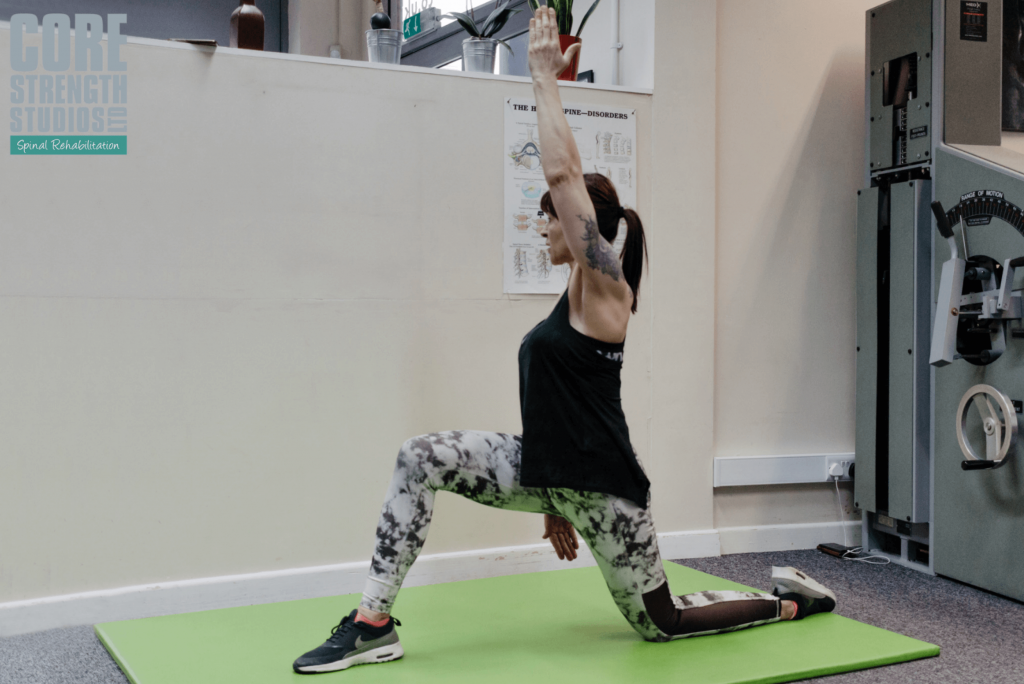
Psoas Stretch
Put one leg in front of the other and lean into the stretch, feeling it along the front of your hip. Lift your arm, rotate slightly and increase the stretch by gently leaning away
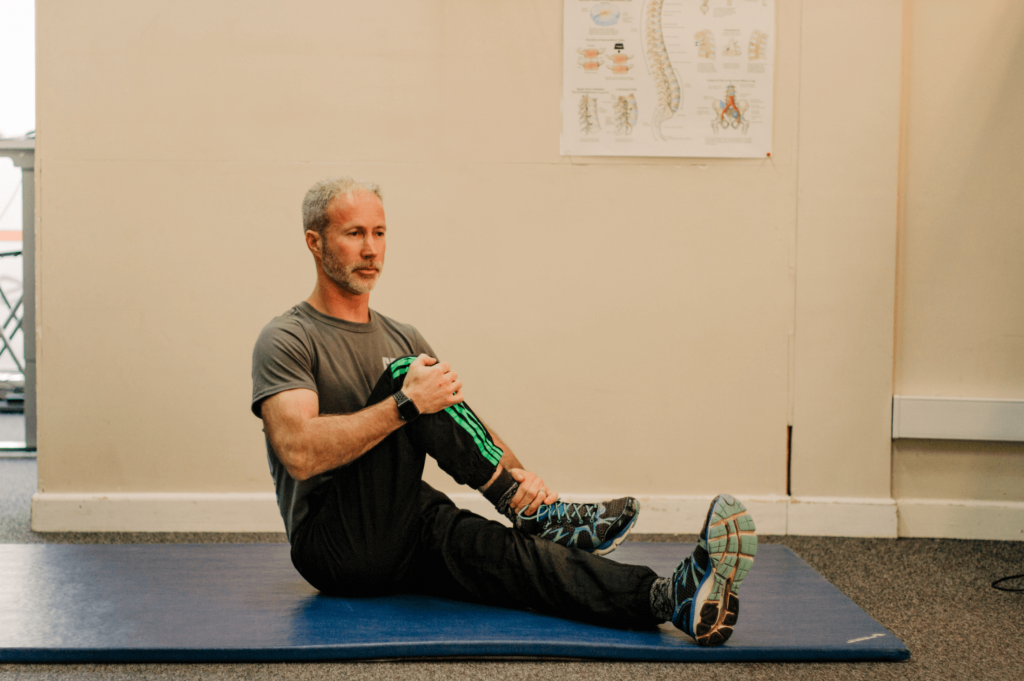
Glute Stretch
Sit with your back straight and cross one leg over the other. Use your arms to pull your knee up towards your chest and your other hand to angle your leg until you feel the stretch in your buttock.

Hamstring Stretch
Use a band or rolled-up towel in the arch of your foot (not the ball of your foot) and keeping your leg straight, gently pull in towards you until you feel the stretch in the back of your thigh.

Chest Stretch
Lying with one leg bent, extend the arm out to the side, keeping your head looking in the opposite direction. Use the other hand to gently push into the floor and extend the stretch so you feel it in your chest.
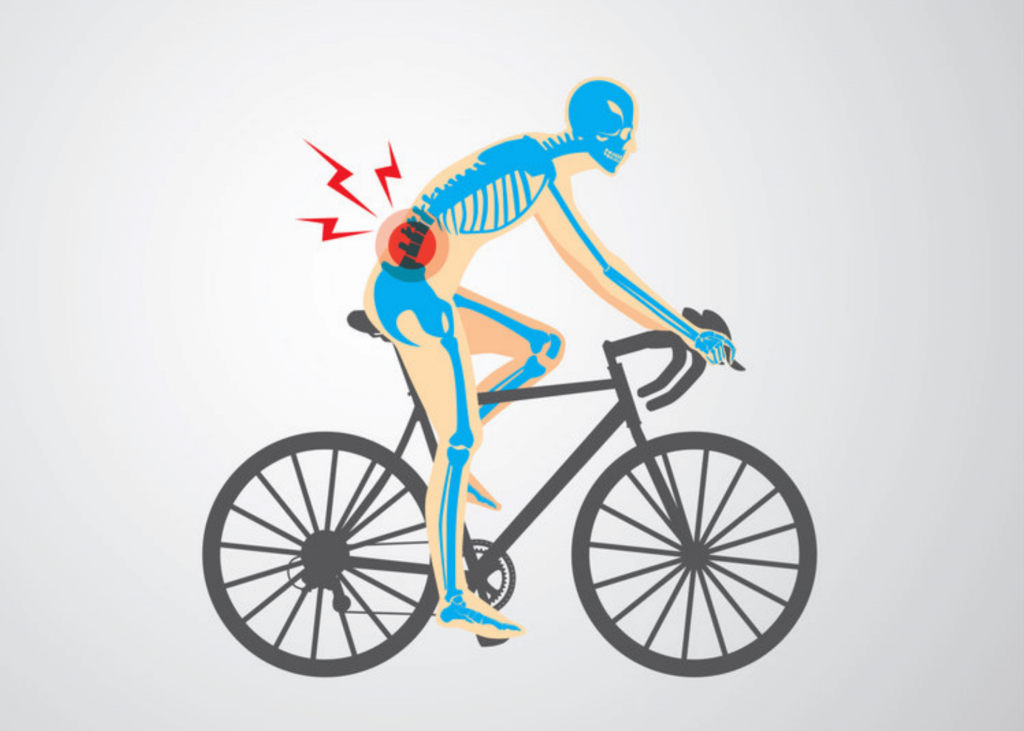
As well as tan lines and inside-leg chain ring imprints, there is something less welcome which many cyclists have in common.
Though it’s frequently thought that knee pain is the main culprit, back pain is in fact the biggest cause of complaint amongst cyclists spending long periods in the saddle.
In one study, out of 116 cyclists who had suffered some kind of overuse injury in the past 12 months, 58% had experienced lower back pain.
So why is it so prevalent in such a low-impact sport? The chances are, the cause of the pain is not limited to any one thing, but a combination of factors which may or may not be correlated.
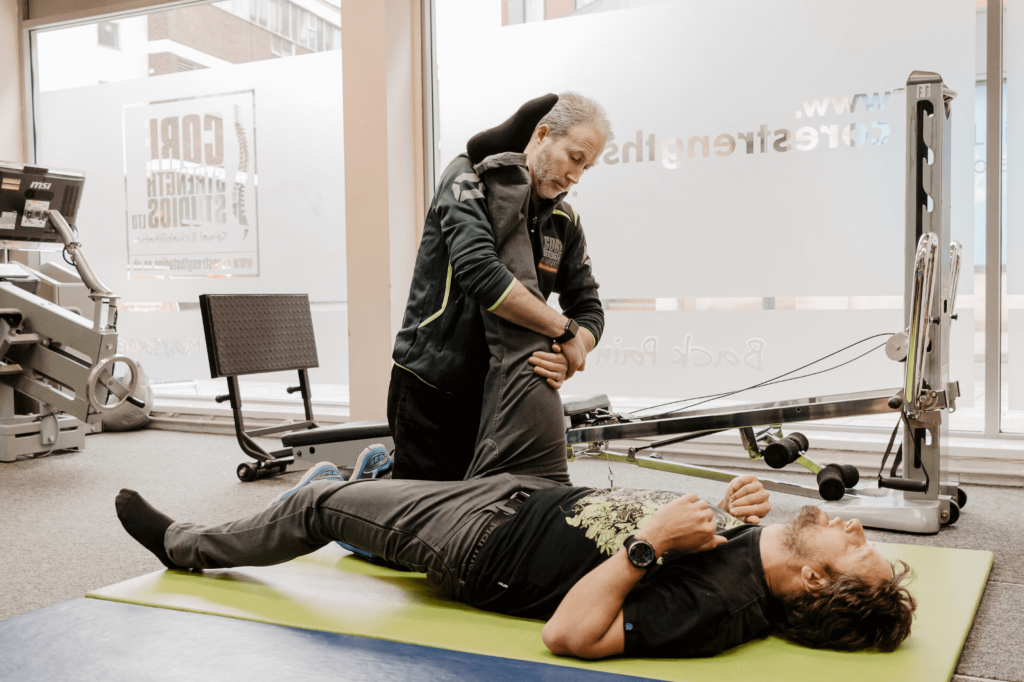
Blame is commonly placed on the little-known psoas muscle. Originating in the low back, it travels through the pelvis and attaches to the thigh bone and is responsible for pulling the leg towards the chest.
Given that this is the position that cyclists find themselves in for long periods of time with the muscle in a shortened state, it’s no surprise, then, that the muscle adaptively shortens, causing the back to arch as the muscle pulls on the spine, causing pain, weakness and muscle imbalances.
This is increased risk in riders who spend long periods sitting during the day, and whose psoas may be in an already shortened state.
Counteract this by stretching the psoas, particularly after a long ride. Kneeling down (see below), put one leg in front of the other, foot on the floor and push your hips forwards until you feel the stretch at the front of your hip (keeping your back straight). Increase the stretch by raising the arm on the same side as your back leg and bending and twisting to the side. Repeat on the other side.
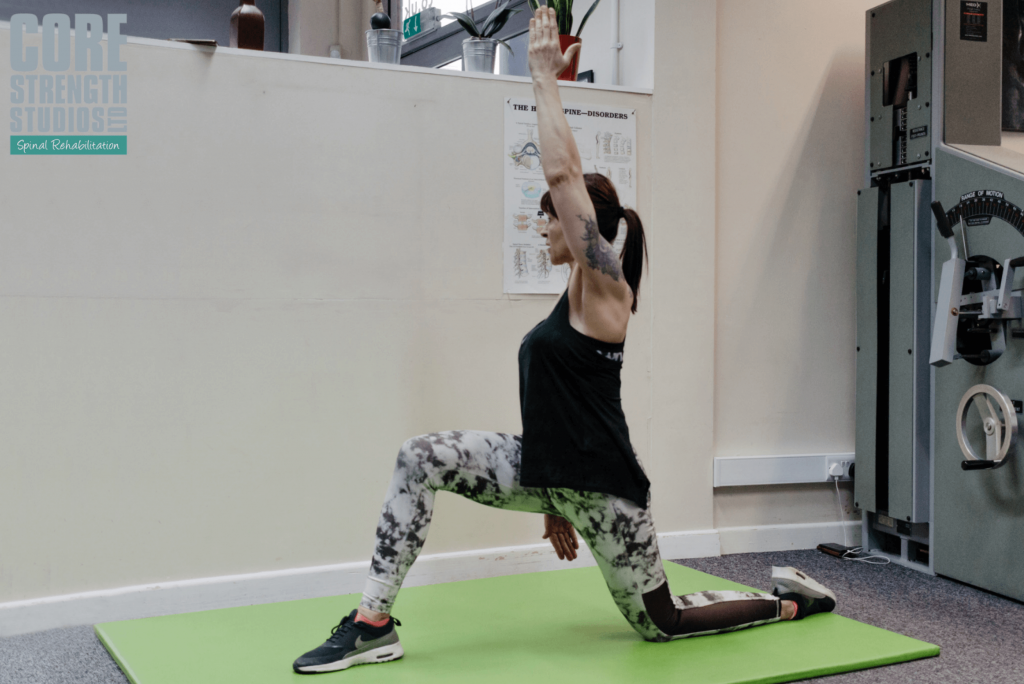
Deep tissue or sports massage on the psoas and low back can also help to release the muscle and ease any tightness.
One of the jobs of the deep core and back muscles are to stabilise the pelvis and back. For cyclists, this means transmitting energy from the trunk down to the pedals without compromising the stability of the spine or pelvis.
When the core is weak, however, this increased instability places additional strain on the back, intensifying the risk of pain, as well as more sinister problems such as slipped discs.
During a ride, the muscles in your legs fatigue. As they tire, your postural muscles may be forced to compensate by taking on additional load. If they are already tired from keeping your position throughout the ride, this additional strain can cause your back to ache.
By performing some simple core strength exercises a couple of times a week, you’re protecting yourself against weakness-related pain and giving your muscles a better chance to support your body and prevent back pain.
Try this quick 10-minute core strengthening routine for back pain
Book a complimentary consultation with a back pain specialist in our Bristol studio to assess your pain, diagnose why your back hurts when you’re cycling and learn how to prevent pain long-term.
To register, complete your details below and we’ll be in touch to book your session.
With the approximate thickness of a pencil and running from the low back down to the feet, the sciatic nerve is the longest nerve in the body.
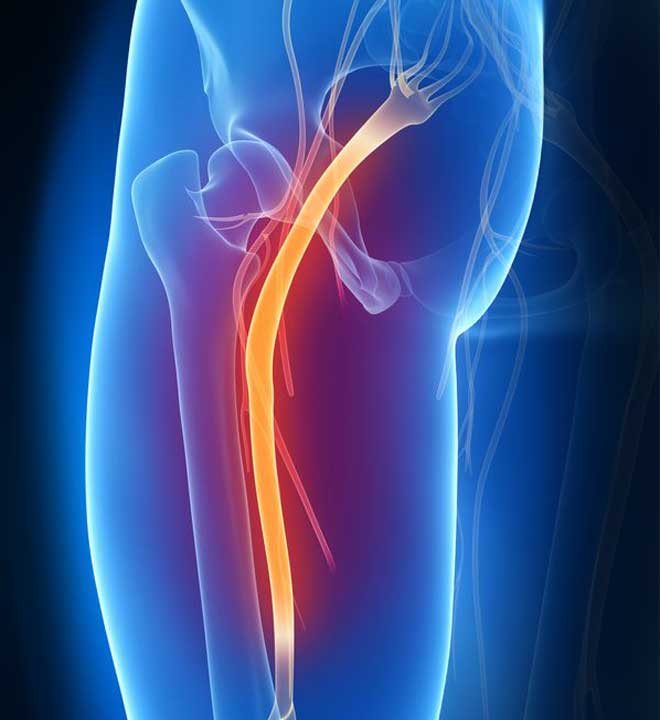
It originates in the lumbar (lower) and sacral (at the base) regions of the spine, travels through the muscles in the buttocks, branches out down the leg and attaches to the foot.
It can become irritated by muscles in its path – most commonly in the buttock or leg – tightening or going into spasm, or by a bulging or herniated disc in the low back pressing into it.
It is also associated with degeneration of the spine, or spinal stenosis, which causes a narrowing of the tunnel which the nerve passes through.
Signs you may be suffering with sciatica include:
· Pain in the low back or buttock, travelling down into the leg and/or foot
· Pins & needles in the leg or foot
· Numbness in the leg or foot
Causes/Contributing Factors
Pregnancy
As the bump grows, your centre of gravity shifts. This can lead to an increased arching of the back which in turn tilts the pelvis forwards. This can sometimes mean that the muscles in the buttocks tighten and pinch on the nerve.
Some women also find that the expanding uterus can press directly on the nerve towards the end of pregnancy, or even as the baby starts to move into position, it can sometimes rest on the nerve.
Slipped disc
A slipped or herniated disc is the most common cause of sciatica. It happens when the outer edge of the intervertebral disc ruptures and the inner jelly-like centre pushes out and presses on the sciatic nerve.
Sometimes the outer edge doesn’t break, but the disc protrudes. This is referred to as a bulging disc and can also put pressure on the nerve.
Disc degeneration/arthritis
As we age, our intervertebral discs may deteriorate. Over time (or sometimes due to injury), the disc can become arthritic, narrow or shrink. This can increase the risk of the disc rupturing and therefore potentially giving rise to sciatica (see above)
The degenerative process could also lead to the development of spinal stenosis, a narrowing of the bone canal through which the sciatic nerve passes which in turn compresses the nerve.
Smoking
Smoking has been associated with a higher risk of developing sciatica. This may be due to the reduced blood flow to the discs, leading to degeneration.
Obesity
Excessive body weight places additional pressure on the back, increasing the rate of degeneration. This increased pressure also increases the risk of disc injuries.
Piriformis syndrome
The Piriformis muscle is located in the buttocks, near the top of the hip joint. The sciatic nerve passes through the Piriformis muscle and can be compressed if the muscle is tight or goes into spasm. This can be caused by prolonged sitting (particularly on hard surfaces), repetitive action during sports (i.e. football, running) or climbing stairs.
Treatment
The type of treatment may vary according to the cause of pain, but will often focus on stretches and flexibility work to restore range of movement, reducing any inflammation and strengthening the back and core muscles to provide support to the spine and prevent the pain coming back.
The first port of call would be a consultation with a back pain specialist to assess your pain and investigate possible causes. From there, a tailored rehabilitation plan can be put in place to reduce your pain and prevent future attacks.
To book a complimentary consultation with a back specialist at Core Strength Studios to assess your sciatica, please complete the form below and we’ll be in touch to book your session.